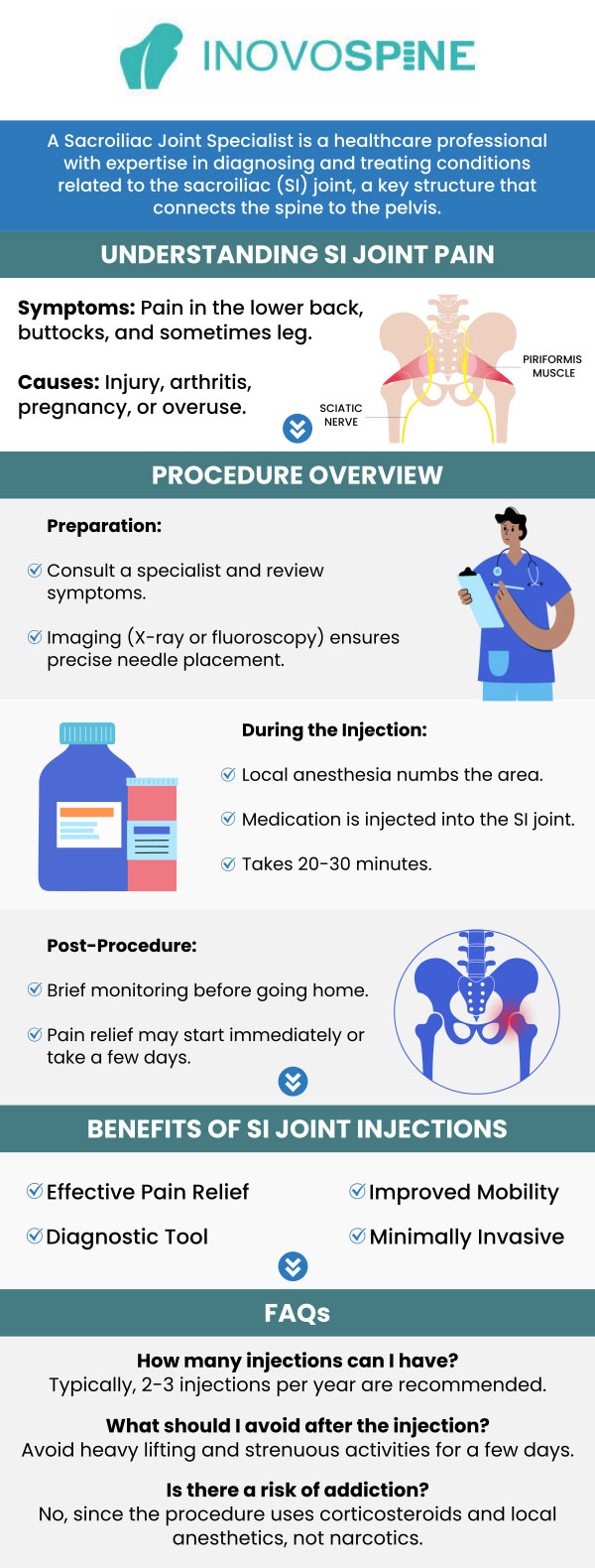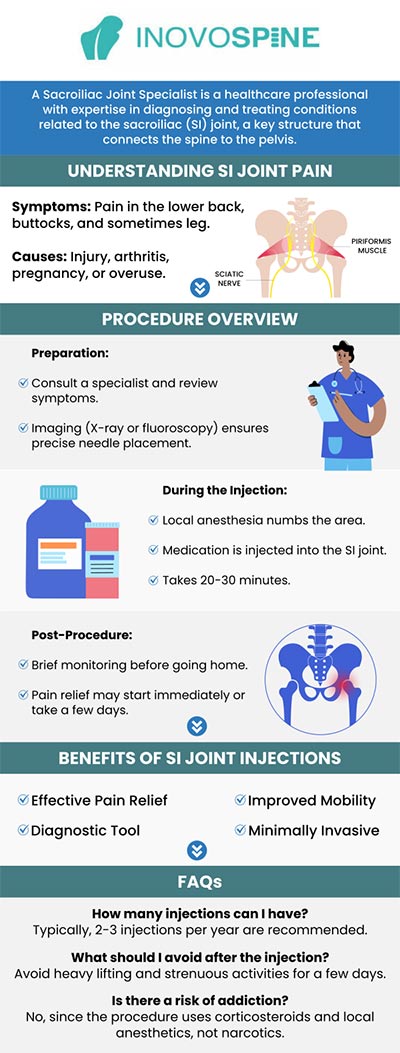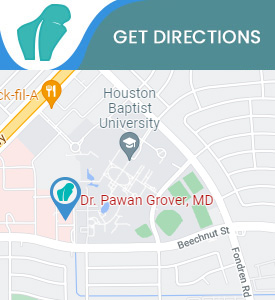Sacroiliac Joint Pain Specialist in Houston, TX
Sacroiliac joint pain can be caused by too loose or too tight joint ligaments that are the result of a fall, work injury, car accident, pregnancy, and childbirth, or hip/spine surgery. Sacroiliac joint pain can affect your life, so don’t delay the treatment and visit InovoSpine to see Dr. Pawan Grover, MDPA for your pain today. For more information, contact us or book an appointment online. We are conveniently located at 1140 Business Center Dr, Suite 110, Houston TX 77043.




Table of Contents:
What causes sacroiliac joint pain?
What does sacroiliac joint pain feel like?
How do you get rid of sacroiliac joint pain?
How long does it take for a sacroiliac joint to heal?
Sacroiliac joint pain occurs when the ligaments that support the joint become too loose or too tight as the result of a fall, work injury, car accident, pregnancy, and childbirth, or hip/spine surgery. There is normally a very small range of motion in the joint, and pain can occur with uneven movement in the pelvis caused by one leg being longer or weaker than the other; arthritis in the hip; or knee problems. Certain factors can increase the risk of developing sacroiliac pain, such as:
Unbalanced gait, such as uneven leg length or scoliosis, can place uneven pressure on one side of the pelvis, causing wear-and-tear on the sacroiliac joint and increasing the risk of pain.
Pregnancy or recent childbirth due to the weight gain and hormonal changes of pregnancy causing the ligaments in the joint to relax, and the pelvic changes associated with childbirth. For some women, the ligaments may remain loose after childbirth causing continued pain and instability.
Prior surgery, in the lower back or a hip joint replacement, can put pressure on the sacroiliac joint.
Continued stress on the joint. Repeated activities such as contact sports, regular lifting of heavyweights, or labor-intensive jobs can aggravate joint pain, as can extended periods of sitting or standing.
Arthritis can attack the sacroiliac joints causing the cartilage to wear down and make movement painful.
The generalized description of sacroiliac joint pain is “lower back pain” but there is much more to it than that. Symptoms experienced with sacroiliac joint pain typically include:
Lower back pain that feels like a dull ache and can range from mild to severe. It is usually only felt on one side, but in some cases can be felt on both.
Pain that extends to the buttocks, hips, and/or groin. One of the most common areas to feel pain is in the buttocks and upper back or side of the thigh and again is usually only felt on one side but may be felt on both.
Sciatic-like pain, a hot, sharp, stabbing pain that may include numbness and tingling in the buttocks and/or backs of the thighs.
Stiffness and reduced range of motion in the lower back, hips, pelvis, and groin areas, which may cause difficulty with movements such as bending at the waist or walking up a flight of stairs.
Increasing pain when extra pressure is put on the sacroiliac joint, such as when climbing stairs, running or jogging, and lying on one side.
Instability in the pelvis and/or lower back, making it feel as though the pelvis is going to buckle or give way when standing, walking, or moving from standing to sitting.
Treatment for sacroiliac joint pain will be different for each person; there is no single “one size fits all” approach that will work for everyone. A combination of non-surgical options is usually needed to effectively relieve the pain, and it can take a while to find which treatments will work best on specific symptoms. Initial treatments typically include:
Rest. A brief rest period of 1 to 2 days may be advised; any longer is not recommended as it could cause more pain and stiffness.
Applying ice or heat. Ice can reduce inflammation and alleviate pain and discomfort; heat applied around the joint can help by relaxing the muscles.
Pain medication. Over-the-counter pain relief medicines such as acetaminophen, ibuprofen, or naproxen may be recommended for mild to moderate pain relief. Prescription muscle relaxants or narcotic painkillers may be used for severe, acute pain but must be used with caution, as they are highly addictive and can cause severe side effects.
Manual manipulation. Massage or manual manipulation by a qualified health professional can be highly effective for sacroiliac joint pain caused by too little motion in the joint. It consists of manual techniques used on the sacroiliac joint and lower back region to reduce joint and muscle stiffness and restore a normal range of motion.
Supports or braces a pelvic brace can be worn for support around the waist if the sacroiliac joint is too loose and needs stabilizing.
Sacroiliac joint injections. Anti-inflammatory medication, such as a corticosteroid, is injected into the joint (along with a local anesthetic) to reduce inflammation and help alleviate pain.
Sacroiliac joint pain can range from mild to severe and will depend on the extent and cause of the injury. Acute sacroiliac joint pain comes on suddenly and usually heals within several days to weeks. Chronic pain, however, lasts for more than three months, and in some cases can be a life-long problem; it may be felt all the time or only when doing certain activities.
If you would like to know more about what causes sacroiliac joint pain and how it’s treated, contact InovoSpine today! We serve patients from Houston TX, Hedwig Village TX, Meadows Place TX, Missouri City TX, Hunters Creek Village TX, Spring Valley Village TX and surrounding areas.

Additional Service You May Need
- Regenerative Medicine
- Spinal Arthritis
- Diagnostic Mapping
- Interventional Pain
- Minimally Invasive
- Spine Pain
- Radiofrequency Ablation
- Spinal Cord Stimulation
- Physical Rehabilitation
- Facet Joint Pain
- Herniated Discs
- Muscle and Joint Pain
- Post-Laminectomy Pain
- Myofascial Pain
- Peripheral Nerve Pain
- Regional Pain Syndrome









